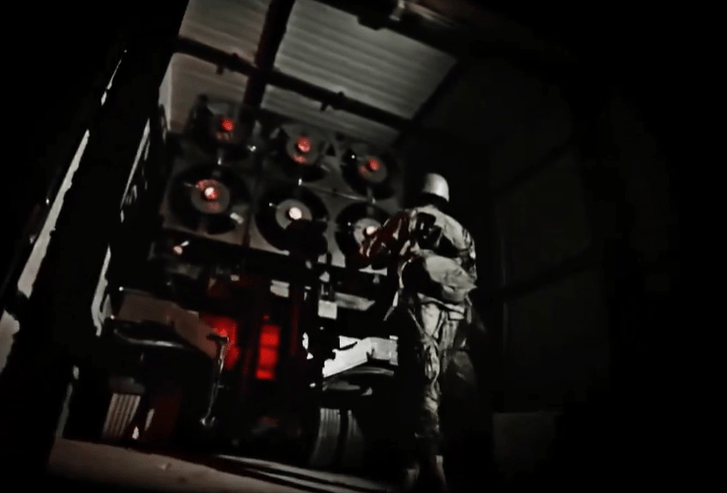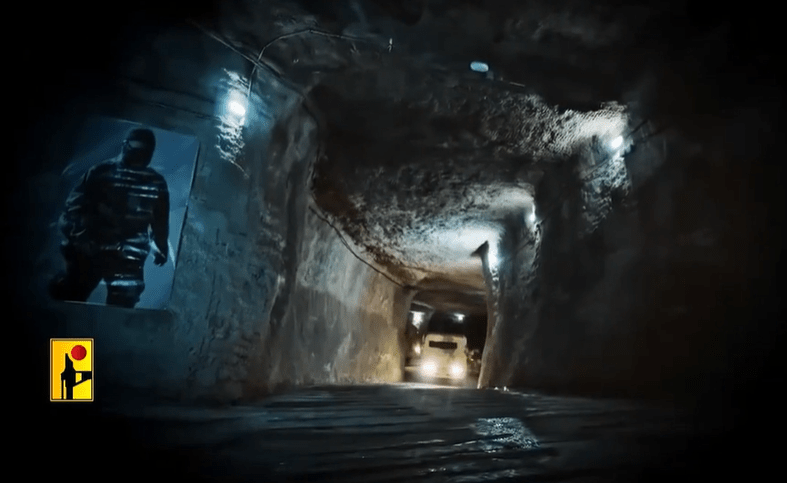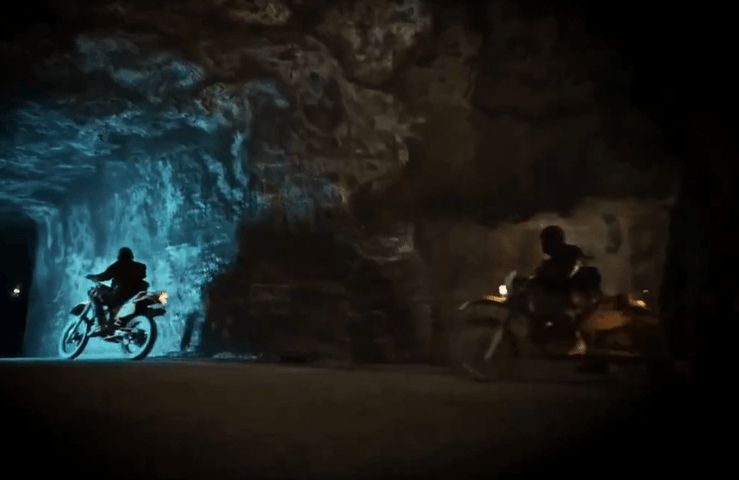
HEZBOLLAH has revealed its hidden terror tunnel network from which missiles can be launched in a chilling threat to Israel.
A blood-curdling video released by the Lebanese terrorists revealed a giant underground roads with enough room for lorries to transport their deadly weapons.
Posters of leaders and soldiers adorn the tall stone walls as heavily armed men speed through the "missile city" in motorbikes.
Trucks loaded with enormous missiles make their way through the dark roads in a frightening glimpse of the terrorists' arsenal.
Drone footage then shows the seemingly endless terror maze, which also appears to be home to military tech and computers.
In the video, the narrator says: "These targets are in our possession and its coordinates are in our hands.
Read more on the Middle East
"These missiles are placed, deployed, and focused on targets and in perfect secrecy."
He added: "The resistance now possesses precision and non-precision missiles, along with weapons capabilities so that if Israel imposes a war on Lebanon, Israel will face a destiny and reality it didn't expect any day.
"War with us extends across all of Palestine - from the Lebanese border to the Jordanian border to the Red Sea, from Qiryat Shemona to Eilat."
Hezbollah is not the only terror group to use hellish bunkers as Hamas also has its own underground rocket factory.
Most read in The Sun
Israeli forces said in January they discovered the hidden facilities beneath a civilian evacuation road and protected by human shields.
The workshops would be where terrorists were said to produce long-range missiles capable of hitting targets in northern Israel.
They also reportedly created replicas or adaptations of standard weaponry such as mortar shells, the IDF claims.
The terror factories were said to be connected through underground shafts to a tunnel network used to transport the weapons to fighting units throughout the Gaza Strip.
Multiple sites along and beneath the Salah a-Din main highway were said to be used by Hamas to manufacture rocket fuel, explosives, projectiles’ bodies, and store them dangerously close to civilians.
Salah a-Din had been declared by the IDF as a humanitarian route for Palestinians to flee from northern Gaza to its south during the early stages of the war.
A variety of metal tubes and components as well as shell casings were stacked in an overground workshop area, while long metal racks holding missiles could be seen elsewhere, with an elevator leading down into the tunnel.
The IDF said it is the largest Hamas weapons production site discovered so far.
"From the elevator, they contain the rockets in a place which is safe and then it goes down to other areas inside the tunnel system," IDF spokesman Rear Admiral Daniel Hagari said.
COUNTDOWN TO CHAOS
It comes as the world is facing a never-ending war as Iran-backed Hezbollah pushes Lebanon towards a bloody Gaza-like fate, experts have warned.
Israel is bracing for an attack from Tehran's largest puppet proxy in Lebanon - where civilians will end up as collateral damage if tensions explode, former intelligence officers said.
After Hamas launched a brutal ambush on Israeli soil in October last year, the Middle East entered a new phase of conflict like it has never seen before.
Israel vowed to obliterate Hamas and poured into the Gaza Strip, engaging in almost 10 months of warfare and airstrikes which have killed tens of thousands of people.
Tehran's sprawling network of proxy groups in the region - namely Hamas in Gaza, Hezbollah in Lebanon and the Houthis in Yemen - have raged against Tel Aviv with a newfound ferocity ever since.
Following a spate of high-profile terrorist assassinations by Israel in recent weeks, a fresh threat of war now looms.
After the death of Hezbollah commander Fuad Shukr in an Israeli airstrike on Beirut in late July, the terror group's leader Hassan Nasrallah vowed to carry out a "strong" revenge strike.
Read More on The US Sun
Israel is expecting a retaliatory hit from Hezbollah before Iran - which has also vowed to seek vengeance for the death of a Hamas commander in capital Tehran on July 31.
The US told its civilians in Lebanon to get on the first flight out available while Brit troops are poised in the region for a military-grade evacuation operation.
Why have tensions in the Middle East suddenly spiked?

By Ellie Doughty, Foreign News Reporter
After almost 10 months of war in Gaza, tensions have hit an all new high following a series of deadly strikes and high-profile assassinations by Israel in late July and early August.
On Saturday July 27, a rocket strike fired from southern Lebanon hit a football pitch in Golan Heights - a Druze village occupied by Israel - killing 12 young people including children.
Israel and the US both said Hezbollah, the largest of Iran’s terror proxy groups, operating out of Lebanon, were responsible for the deadly strike.
On Monday July 28, the IDF dropped an airstrike on an area of Beirut, Lebanon’s capital, killing Hezbollah’s most senior military commander Fuad Shukr.
Less than two days later, at around 2am on Wednesday July 30, Israel killed Hamas’ top political leader Ismail Haniyeh as he slept in Iran’s capital Tehran.
Israel has yet to explicitly claim responsibility for the hit, but after vowing to take out all of Hamas last year, they are widely believed to be behind it.
US officials have also said they suspect Israel of being behind the assassination.
On the morning of Thursday August 1 morning the Israeli Defence Forces (IDF) announced that a strike on Khan Younis, southern Gaza, had killed Mohammed Deif on July 13.
Dief had worked as head of Hamas' ruthless military wing, the al-Qassam brigades, since 2002.
It marked another major loss for Iran’s terror proxy groups in the region.
Early reports this week suggested Ismail Haniyeh was taken out in a precision strike, when a rocket was fired from a drone outside his window and detonated inside the room.
Then an investigation by the New York Times suggested a bomb had been planted in his room at the military-run compound where he was staying and detonated remotely.
Unnamed Iranian officials also shared the explosive theory with The Telegraph, further confusing the murky details around Haniyeh’s death.
The Iranian Revolutionary Guard Corps (IRGC), concluded its investigation into the humiliating security breach on Saturday August 1 and said he died after a “short-range projectile” was fired from outside the building.
A statement shared on Iranian state TV said a 7kg rocket warhead was used in the attack.
Iran and its proxy groups; Hamas in Gaza, Hezbollah in Lebanon and the Houthis in Yemen all vowed to seek revenge on Israel over the assassination of Haniyeh.
Then, on the night of Saturday August 3, Hezbollah fired some 30 rockets from Lebanon towards Galilee in northern Israel.
Tel Aviv’s impressive Iron Dome Defence system launched into action, destroying “most” of the missiles and no one was hurt.
But the UK, US and France have all urged their citizens to evacuate from Lebanon as fears of a wider war breaking out in the region continue to spiral.





















